Mount Myogi

|
A famous mountain in western Gunma Prefecture. Together with Mount Akagi and Mount Haruna, it is known as one of the three great Jomo mountains. It is also rich in scenic beauty with its oddly shaped rocks and bizarre stones, and is considered one of Japan's three most beautiful places of scenic beauty along with Yabakei and Kankakei. In 1923 (Taisho 12), it was designated as a national scenic spot, and in 1954 (Showa 29), part of it became a prefectural park. In 1969, it was also designated as Myogi Arafune Saku Kogen Quasi-National Park. The mountain is divided into three peaks, Mount Hakuun, Mount Kondo (the highest at 1,104 meters), and Mount Kinkei, and is composed mainly of hard pyroxene andesite and soft tuff breccia, and differences in resistance to erosion have created cliffs such as the Byobu Rock seen on Mount Kindo, and strange sights such as the First, Second, Third and Fourth Stone Gates, Taiho Rock, Cannon Rock and Hitto Rock. There are iron chains and ladders in several places, such as the "Crab Crawl," and the climbing course is thrilling and varied. The character "dai" (big), named after Myogi Daigongen on the eastern side of Mt. Hakuun, was made by bundling bamboo into a large shape with offerings attached, and can be seen from train windows near Matsuida Station on the JR Shinetsu Main Line. The cliffs on the western side, known as Ura Myogi, are a rough road and few people visit. It is a 10-minute taxi ride from Matsuida Station, the main trailhead, to Myogi Shrine at the foot of the mountain. A prefectural road leads from the Myogicho area of Tomioka City, past the Kinkei mountainside, beside the First Stone Gate, and Nakanodake Shrine, to Shimonita Town. The autumn leaves, reflected against the oddly shaped rocks, make for a spectacular sight. [Murakami Sadao] [Reference] | |A strange peak in the western part of Gunma Prefecture. It is one of the "Three Mountains of Jomo" and is counted among Japan's Three Great Scenic Spots due to its abundance of scenic beauty with oddly shaped rocks and bizarre stones. The mountain is divided into three peaks, which are Kinkei-san, Kindo-san, and Hakuun-san (from left to right in the photo). Myogi-Arafune-Saku-Kogen Quasi-National Park. Nationally designated scenic spot Tomioka City, Kanra-gun Shimonita-cho, and Annaka City, Gunma Prefecture © Tomioka City Tourism Association "> Mount Myogi Source: Shogakukan Encyclopedia Nipponica About Encyclopedia Nipponica Information | Legend |
|
群馬県西部にある名山。赤城山(あかぎやま)、榛名山(はるなさん)とともに上毛三山(じょうもうさんざん)とよばれ、また、奇岩、怪石の景勝に富むので、耶馬渓(やばけい)、寒霞渓(かんかけい)と並んで日本三大奇勝の一つにあげられる。1923年(大正12)国指定の名勝となり、1954年(昭和29)一部が県立公園になった。1969年には妙義荒船佐久高原国定公園(みょうぎあらふねさくこうげんこくていこうえん)にも指定されている。山体は白雲山(はくうんざん)、金洞(こんどう)山(1104メートルで最高)、金鶏(きんけい)山の三峰に分かれて鼎立(ていりつ)し、おもに硬い輝石安山岩と軟らかい凝灰角礫(かくれき)岩からなり、侵食に対する抵抗力の差異の結果、金洞山にみる屏風岩(びょうぶいわ)などの絶壁や、第一、二、三、四石門(せきもん)、大砲岩(たいほういわ)、ロウソク岩、筆頭岩(ひっとういわ)などの奇観がつくられた。「カニの横這(よこばい)」など鉄の鎖や梯子(はしご)が数か所にあり、登山コースはスリルと変化に富む。白雲山東腹の妙義大権現(ごんげん)にちなむ「大」の字は、竹を大の字形に束ね幣帛(へいはく)をつけて建てたもので、JR信越本線松井田(まついだ)駅付近の車窓からも見える。裏妙義といわれる西側の断崖(だんがい)地は険路なので訪れる者は少ない。表登山口の松井田駅から麓(ふもと)の妙義神社までタクシーで10分。県道が富岡市妙義町地区から金鶏山腹、第一石門の傍ら、中ノ岳神社を経て下仁田(しもにた)町に通じる。秋の紅葉は奇岩に映えて絶景である。 [村木定雄] [参照項目] | |群馬県西部にある奇峰。「上毛三山」の一つで、奇岩・怪石の景勝に富むことから日本三大奇勝の一つにも数えられる。山体は3峰に分かれ、写真左から金鶏山、金洞山、白雲山。妙義荒船佐久高原国定公園。国指定名勝 群馬県富岡市・甘楽郡下仁田町・安中市©富岡市観光協会"> 妙義山 出典 小学館 日本大百科全書(ニッポニカ)日本大百科全書(ニッポニカ)について 情報 | 凡例 |
Recommend
Itami Airport
Common name for Osaka International Airport. Sourc...
painted maple
...It is found in the temperate to subarctic lowe...
Arima [Hot Springs] - Arima
It is located in Kobe City's Kita Ward, at an ...
Anthroposophie (English spelling) German
It refers to the mystical theory and educational ...
Stump-tailed skink (Japanese name)
A skink lizard with a short, truncated tail (illus...
Hirafuku Hyakusui
Japanese painter. Born in Kakunodate, Akita Prefe...
URN - Urn
Uniform resource name : A description method for s...
Aspergillus oryzae (English spelling) Koji‐fungus
A general term for fungi of the genus Aspergillus....
Krefeld
…The 1860 Treaty of Amity and Commerce of England...
Vampire bat (blood-sucking bat)
A general term for bats that feed on the blood of ...
Palais du Louvre
This is an old French royal palace located on the...
Uchikaifu Coast - Uchikaifu Coast
...The center of tourism in Sado is the sheer sca...
Ema - Ema
These are pictures that are offered to deified obj...
Multimodal transportation - Fukugo Ikkan Yuso (English)
The transport of cargo by combining two or more di...
Remote Island - Ritou
An island that is separated from the mainland by ...


![Ibaraki [city] - Ibaraki](/upload/images/67caf101a4d94.webp)






